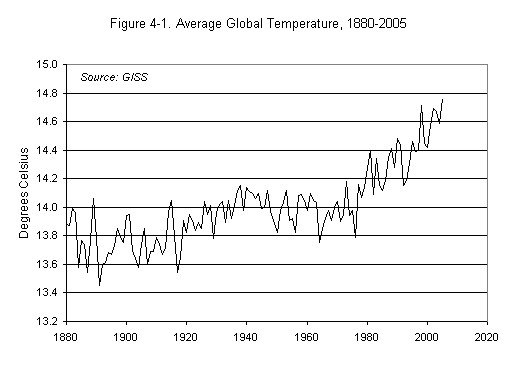Lester R. Brown
Chapter 4. Rising Temperatures and Rising Seas: Rising Temperature and Its Effects
Scientists at the National Aeronautics and Space Administration’s Goddard Institute for Space Studies gather data from a global network of some 800 climate-monitoring stations to measure changes in the earth’s average temperature. Their records go back 125 years, to 1880. 8
Since 1970, the earth’s average temperature has risen by 0.8 degrees Celsius, or nearly 1.4 degrees Fahrenheit. During this span, the rise in temperature each decade was greater than in the preceding one. (See Figure 4–1.) Meteorologists note that the 22 warmest years on record have come since 1980. And the six warmest years since recordkeeping began in 1880 have come in the last eight years. Three of these six—2002, 2003, and 2005—were years in which major food-producing regions saw their crops wither in the face of record temperatures. 9
The amount of CO 2 in the atmosphere has risen substantially since the Industrial Revolution, with most of the rise coming since recordkeeping began in 1959. Since then it has risen every year, making this one of the world’s most predictable environmental trends. As shown in Figure 4–2, CO 2 levels turned sharply upward around 1960. Roughly a decade later, around 1970, the temperature too began to climb. 10
Against this backdrop of record increases, the projections of the Intergovernmental Panel on Climate Change (IPCC) that the earth’s average temperature will rise 1.4–5.8 degrees Celsius (2.5–10.4 degrees Fahrenheit) during this century seem all too possible. Recent data on the temperature rise in some northern regions—such as Alaska, western Canada, and Siberia—coupled with the accelerated melting of the Greenland ice sheet, the melting of glaciers in mountain ranges throughout the world, and the likelihood at this writing that the global temperature for 2005 will set yet another record high all suggest that the global temperature rise will be close to the upper end of the IPCC projected range. Such an increase—of 5.8 degrees Celsius by 2100, a rise comparable to that between the last Ice Age and today—will create a world far different from the one we know. 11
At a practical level, the IPCC projected rise in temperature is a global average. In reality, the rise will be very uneven. It will be much greater over land than over oceans, in the higher latitudes than over the equator, and in the continental interiors than in coastal regions. 12
Higher temperatures diminish crop yields, melt the snow/ice reservoirs in the mountains that feed the earth’s rivers, cause more destructive storms, increase the area affected by drought, and cause more frequent and destructive wild fires. 13
In a paper presented at the American Meteorological Society’s annual meeting in San Diego, California, in January 2005, a team of scientists from the National Center for Atmospheric Research reported a dramatic increase in the earth’s land surface affected by drought over the last few decades. They reported that the land experiencing very dry conditions expanded from less than 15 percent of the earth’s total land area in the 1970s to roughly 30 percent by 2002. They attributed part of the change to a rise in temperature and part to reduced precipitation, with high temperatures becoming progressively more important during the latter part of the period. Lead author Aiguo Dai reported that most of the drying was concentrated in Europe and Asia, Canada, western and southern Africa, and eastern Australia. 14
Researchers with the U.S. Department of Agriculture’s Forest Service reported that even a 1.6-degree-Celsius rise in summer temperature could double the area of wildfires in the 11 western states. The study, published in the August 2004 issue of Conservation Biology, drew on 85 years of fire and temperature records. 15
The National Wildlife Federation (NWF) reports that if temperatures continue to rise, by 2040 one out of five of the Pacific Northwest’s rivers will be too hot for salmon, steelhead, and trout to survive. Paula Del Giudice, Director of the Federation’s Northwest Natural Resource Center, notes that “global warming will add an enormous amount of pressure onto what’s left of the region’s prime cold-water fish habitat.” 16
Ecosystems everywhere will be affected by higher temperatures, sometimes in ways we cannot easily predict. The Pew Center for Global Climate Change sponsored a mega-study analyzing some 40 scientific reports that link temperature with changes in ecosystems. Among the many changes reported are spring arriving nearly two weeks earlier in the United States, tree swallows nesting nine days earlier than they did 40 years ago, and a northward shift of red fox habitat that has it encroaching on the Arctic fox’s range. Inuits were surprised by the appearance of robins, a bird they had never seen before. Indeed, there is no word in Inuit for “robin.” 17
Hector Galbraith of the University of Colorado-Boulder, a co-author of the Pew study, indicated that “the effects of this change are occurring much more rapidly than...expected.” He also said “that ecosystems are much more sensitive to climate change than believed a decade ago.” A study sponsored by Conservation International has predicted that continued climate change could drive more than a quarter of all land animals and plants to extinction. 18
Douglas Inkley, NWF Senior Science Advisor and senior author of a report to the Wildlife Society, notes, “We face the prospect that the world of wildlife that we now know—and many of the places we have invested decades of work in conserving as refugees and habitats for wildlife—will cease to exist as we know them, unless we change this forecast.” 19 
*Data and additional resources have been omitted from this mobile version of our website to ensure the most optimal experience. To view this page with its entire information, please visit the full website.